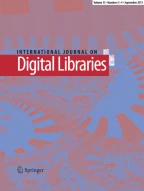Abstract
In the last decade, Europe has put a tremendous effort into making cultural, educational and scientific resources publicly available. Based on national or thematic aggregators, initiatives like Europeana nowadays provide a plethora of cultural resources for people worldwide. Although such massive amounts of rich cultural heritage content are available, the potential of its use for educational and scientific purposes still remains largely untapped. Much valuable content is only available in the so-called long tail, i.e. in niche resources such as specifically themed cultural heritage collections, and are difficult to access from the mainstream hubs like major search engines, social networks or online encyclopaedias. The vision of the EEXCESS project is to push high-quality content from the long tail to platforms and devices which are used every day. The realisation of such use cases requires as a basis (and in addition to the functional components) a common metadata representation and tools for mapping between the data sources’ specific data models and this common representation. In this paper, we propose a data model for such a system that combines federated search results from different cultural heritage data sources. We then propose an approach for metadata mapping, with a focus on easy configurability of mappings, which—once properly configured—can then be executed on the fly by an automatic service. We demonstrate the approach using a real-world example.
Similar content being viewed by others
Notes
Available at: http://eexcess.joanneum.at/configtool/. Contact feedback@eexcess.eu for obtaining a user account.
References
RDA Element analysis: Technical report 5JSC/RDA/Element analysis/Rev/2, Joint Steering Committee for Development of RDA (2008)
Boeuf Le P., Doerr, M., Emil Ore, C., Stead, S.: Definition of the CIDOC conceptual reference model, v. 5.1.2. (2014). http://www.cidoc-crm.org/docs/cidoc_crm_version_5.1.2.pdf
Clark, J., DeRose, S.: XML path language (XPath) version 1.0. W3C recommendation 16 november 1999. W3C Recommendation (1999)
Cruz, I.F. Xiao, H., Hsu, F.: An ontology-based framework for XML semantic integration. In: IDEAS, pp. 217–226 (2004)
Dean, M.: Schreiber G.: OWL web ontology language: reference. W3C Recommendation, 10 February (2004). http://www.w3.org/TR/owl-ref/
Doerr, Martin: The CIDOC conceptual reference module: an ontological approach to semantic interoperability of metadata. AI Mag. 24(3), 75–92 (2003)
Europeana data model, version 5.2.4 (2013). http://pro.europeana.eu/edm-documentation
Europeana data model primer (2013). http://pro.europeana.eu/documents/900548/770bdb58-c60e-4beb-a687-874639312ba5
EEXCESS—Enhancing Europe’s Exchange in Cultural Educational and Scientific Resources. http://eexcess.eu/
Haslhofer, B., Klas, W.: A survey of techniques for achieving metadata interoperability. ACM Comput. Surv. 42(2), 7:1–7:37 (2010)
Haslhofer, B., Sanderson, R., Simon, R., van de Sompel, H.: Open annotations on multimedia Web resources. Multimed. Tools Appl., 70(2):847–867 (2014)
Höffernig, M., Bailer W.: Formal metadata semantics for interoperability in the audiovisual media production process. In: Workshop on Semantic Multimedia Database Technologies (SeMuDaTe), Graz, AT, Dec (2009)
Höffernig, M., Bailer, W., Nagler, G., Mülner, H.: Mapping audiovisual metadata formats using formal semantics. In: Declerck, T., Granitzer, M., Grzegorzek, M., Romanelli, M., Rüger, S., Stefan M., Sintek, M. (eds.) SAMT, volume 6725 of Lecture Notes in Computer Science, pp. 80–94. Springer, Berlin (2010)
Kondylakis, H., Doerr, M., Plexousakis, D.: Mapping language for information integration. Technical Report 385, ICS-FORTH (2006)
Lee, W., Bailer, W., Bürger, T., Champin, P.-A., Evain, J.-P., Malaise, V., Michel, T., Sasaki, F., Söderberg, J., Stegmaier, F., Strassner, J.: Ontology for Media Resources 1.0, W3C Recommendation February (2012)
Michal, K.: XSL transformations (XSLT) version 2.0. W3C Recommendation (2007)
Miles, A., Bechhofer, S.: SKOS simple knowledge organization system reference. W3C Recommendation (2009)
Olensky, M., Doerr, M., Gradmann, S.: Final report on EDM - FRBRoo application profile task force. Technical report, Europeana v2 project (2013)
ORE User Guide-Primer. Oct. (2008). http://www.openarchives.org/ore/1.0/primer.html
Poppe, C., Martens, G., Mannens, E., Van de Walle, R.: Personal content management system: a semantic approach. J. Vis. Comuun. Image Represent. 20(2), 131–144 (2009)
PROV Model Primer. Apr. (2013). http://www.w3.org/TR/2013/NOTE-prov-primer-20130430/
Prud’hommeaux, E., Seaborne, A.: SPARQL Query Language for RDF. W3C Recommendation (2008)
Sanderson, R., Ciccarese, P., Van de Sompel, H.: Open annotation data model (2013). http://www.openannotation.org/spec/core/
Sanderson, R., Van de Sompel, H.: Making web annotations persistent over time. In Proceedings of the 10th annual joint conference on Digital libraries, JCDL ’10, pp. 1–10, New York, NY, USA, ACM (2010)
Saur, K.G.: Functional requirements for bibliographic records : final report. Technical report, IFLA Study Group on the Functional Requirements for Bibliographic Records (1998)
van Ossenbruggen, J., Hildebrand, M., de Boer, V.: Interactive vocabulary alignment. In: Gradmann, S., Borri, F., Meghini, C., Schuldt, H.: (eds.). TPDL, volume 6966 of Lecture Notes in Computer Science, pp. 296–307. Springer, Berlin (2011)
Author information
Authors and Affiliations
Corresponding author
Additional information
The research leading to these results has received funding from the European Union’s Seventh Framework Programme (FP7/2007–2013) under Grant agreements No. 231161, “PrestoPRIME” and No. 600601, “EEXCESS”.
Rights and permissions
About this article
Cite this article
Orgel, T., Höffernig, M., Bailer, W. et al. A metadata model and mapping approach for facilitating access to heterogeneous cultural heritage assets. Int J Digit Libr 15, 189–207 (2015). https://doi.org/10.1007/s00799-015-0138-2
Received:
Revised:
Accepted:
Published:
Issue Date:
DOI: https://doi.org/10.1007/s00799-015-0138-2
